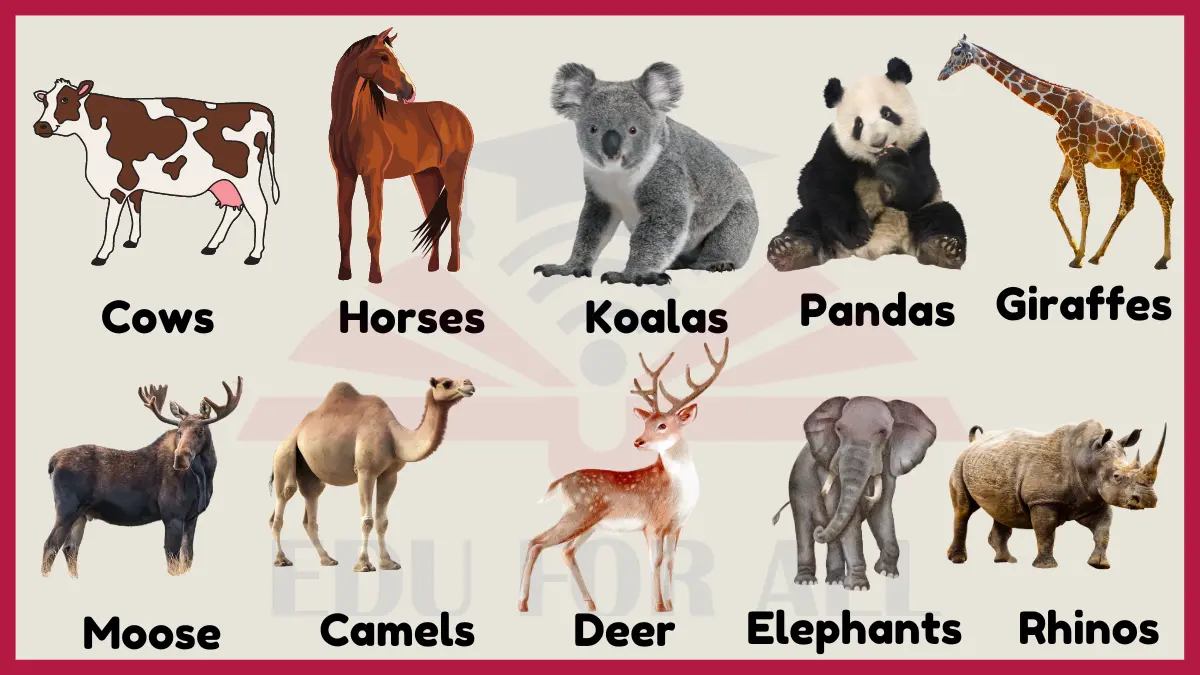Elephants, cows, deer, giraffes, rabbits, horses, and koalas are examples of herbivores. Herbivores obtain the nitrogen, protein, and energy they need by consuming plant matter. Plants contain essential nutrients, including proteins, carbohydrates, and other organic compounds, which herbivores break down during digestion to meet their nutritional requirements.
The digestive systems of herbivores are adapted to extract nutrients from plant cellulose, allowing them to derive energy and build essential biomolecules like proteins from the plant material they consume.

Also Read Examples of Omnivores
Examples of Herbivores
Here are 12 examples of herbivores:
1: Cows
Cows are considered herbivores because the main part of their diet consists of eating grasses and plants. Their digestive system is specialized to break down cellulose which is found in plant cell walls.
Do You Know?
Cows spend 8 hours a day eating.
2: Horses
Horses are herbivores that graze on grasses and some shrubs all day long. They have very long intestines to allow their food more time to break down and absorb nutrients.
Do You Know?
Horses have the largest eyes of any land mammal.
3: Koalas
Koalas survive entirely on a diet of eucalyptus leaves, which are very low in nutrients. Special bacteria and longer intestines allow them to digest this difficult diet.
Do You Know?
Koalas sleep up to 22 hours a day to conserve energy since eucalyptus leaves provide so little calories.
4: Pandas
Giant pandas consume up to 38 pounds of bamboo per day due to the extremely low calorie content of bamboo. They have an elongated wrist bone that functions as an opposable thumb to assist in grasping bamboo.
Do You Know?
Pandas spend 10-16 hours a day filling their large appetites almost exclusively with bamboo.
5: Giraffes
Giraffes use their 20 inch long tongues and tough lips to forage for leaves high in the trees that other herbivores cannot reach. A network of capillaries in the brain protect it from sudden changes in blood pressure when they lower their necks.
Do You Know?
Giraffes only need 5-30 minutes of sleep per day.
6: Moose
Moose are the largest members of the deer family, eating 70 pounds of leaves, twigs, shrubs, aquatic plants and grass per day. Their broad, overhanging upper lip helps bring vegetation into their mouth.
Do You Know?
Moose antlers can span 6 feet across and weigh 40 pounds.
7: Camels
Camels obtain most of their moisture from the plants they eat, succulents, thorny or dry vegetation other animals avoid. Their oval red blood cells, kidneys and intestines conserve water in arid climates.
Do You Know?
Camels can go 5-7 days without water and lose up to 30% of their body weight as moisture without becoming dehydrated.
8: Deer
Deer are ruminant mammals with a four-chambered stomach allowing them to digest plants like leaves, twigs, bark, shoots, fruit and grass. Only male deer grow antlers for battling other males during mating season.
Do You Know?
Deer antlers are the fastest growing tissue in nature, growing as much as 1 inch per day.
9: Elephants
Elephants are one of the most important examples of herbivores. spend 16 hours a day consuming 350 pounds of grasses, fruit, twigs, tree bark and roots which their plate-like molars efficiently grind up. The trunks powerful muscles and sensitive fingerlike projections provide excellent food handling ability.
Do You Know?
Elephant tusks grow throughout their lifetime and can exceed 250 pounds.
10: Rhinos
Rhinos are herbivores that spend half the day eating thorny shrubs, leafy plants, branches and fruit their leathery lips protect their mouths from. Some rhinos use their horns to dig up roots and break branches.
Do You Know?
The Indian Rhino has folds of skin that resemble armor plating but are only thickened skin.
11: Sloths
Sloths survive on leaves, buds and shoots from only a few select trees, thanks to special bacteria in their guts that release nutrients. Their slow metabolism and inactivity conserves their limited energy from digesting their low fuel diet.
Do You Know?
Sloths descend to the forest floor only once a week urinate and defecate.
12: Gorillas
Gorillas are the largest primate and almost entirely herbivorous, eating fibrous stems, bamboo shoots and fruit. Large, sharp canine teeth intimidate rivals or predators without harming either.
Do You Know?
Gorillas can eat up to 40 pounds of vegetation a day.
Related Articles

